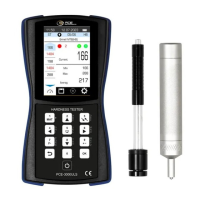18
gauges of the static principle of action with the created small and ultralow loading.
The reliability of the control must be assessed by comparing the readings of the
hardness tester with the results of measurements by devices of the static principle of
operation.
1.11 Measurements on materials with high surface roughness
When measuring a product with a high surface roughness (above specified in paragraph
1.7 "Requirements for the controlled product"), there may be high additional variance in the
readings of the device.
There are two ways to eliminate the additional scatter:
Clean the area of the surface (for example, using a grinder according to item 1.6
"Additional devices and devices") to obtain the required roughness in the area defined in item
1.7 "Requirements for the controlled product".
When measuring, use more averages. It is recommended only if for any reason it is
impossible to clean the surface. In some cases, this method can lead to underestimation of the
hardness tester, such as the presence of regular irregularities on the surface of the product
(rough turning of the product surface).
When measuring a product with high surface roughness, it is recommended to use
algorithms to reject the results of incorrect measurements. (see paragraph 2.7 "Setting
averaging parameters").
1.12 Influence of surface properties of coatings and hardened layers
Unlike devices of the static principle of action when carrying out measurements, the
indenter of the probe of the hardness tester creates prints of small depth (see item 1.5 "Probes
of the hardness tester", table 1.4). Therefore, the hardness of the surface layer of the product
is measured directly.
On the controlled product in the manufacturing process may be thin surface layers that
differ in hardness from the bulk of the metal. Example:
− Carbon-free layer with low hardness formed due to high-temperature heat
treatment (hardening, normalization, hot rolling, forging, etc.).

